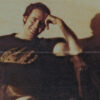After the credits rolled when “The Great Invisible” premiered at SXSW, Margaret Brown made a point of thanking all those in Austin who sat through “some really humiliating screenings” as she worked on editing the film about the devastation of the BP oil spill on both the community she grew up in on the Gulf Coast of Alabama and those who were on the rig on April 20, 2010.
“I was miserable for years,” says Brown, who won the Grand Jury Prize for Best Documentary at the festival for the follow-up to her much-beloved documentaries “The Order of Myths” and “Be Here to Love Me: A Film About Townes Van Zandt.” “I was finding the story for a very long time because I had some characters, but I kept reaching these points where I was like, ‘It’s not quite there.’”
According to Brown, it was only two months before its world premiere that she captured the film’s emotional climax and for a long time, she was working on an entirely different cut. Yet such is the filmmaker’s skill that the film, which earned a standing ovation on Sunday when it debuted, appeared to effortlessly filter the enormous scope of the Deepwater Horizon explosion through a human lens, extrapolating the cut corners and cost-cutting that led to the disaster and taking into account everyone who was affected, from the rig workers who bear the physical scars of the incident to the shrimpers and fishermen who have endured the psychological scars of being out of work.
Over the past three years, Brown traveled everywhere from the Hemley Road Church of Christ in Alabama’s seafood capital Bayou La Batre to the Offshore Technology Conference in Houston to get a gauge on the true price of oil and finds a truly rich story in between. A day after the film’s triumphant bow in Austin, Brown spoke about the challenging editing process, how she eavesdropped on a frank conversation between oil execs and earning the trust of all her subjects.
During the post-premiere Q & A, it was striking to see that it was the wives of the men that were your subjects who were involved in the BP oil spill that stepped up to the mic. Was that in any way indicative of something you may have had to overcome in the making of this film in terms of getting everyone to open up about their experiences?
Those guys have PTSD and they don’t do really well with crowds. [Former Deepwater Horizon Chief Mechanic] Doug [Brown] just had an operation on his neck that has to do with Deepwater Horizon. A week later, he still flew down here. That’s how important it is to him. Afterwards, I was like, “Doug, tomorrow night you have to say something.” For these guys, it’s like soldiers in Iraq. They have issues with crowds and with flashback stuff. I think their wives have almost changed their relationship just by dealing with the disaster. It’s really intense. It’s not that they don’t have a voice, because I spoke to them in the movie, but it’s more that all these people gave them a standing ovation and it’s just overwhelming to them.
Of course, the BP oil spill literally hit home for you since you grew up in Alabama. When disaster struck, did your mind automatically go there?
It was mainly that my dad and my mom live on the water. Their house was surrounded by the orange booms that BP was using to prevent oil from getting into the estuaries and marshes. My dad started sending me pictures of our house surrounded by these orange booms, and of BP workers or contractors working for BP just everywhere. It was like an invasion. It made me angry and it felt really personal. I was making another movie, and I put that on hold and started making this one.
It’s commonplace among documentarians to shoot interviews from inside cars, but did it take on a special significance for you here, considering what they run on?
It was very intentional. Maybe this is super obvious, but we all use cars. Even the people who are impacted by this still have to get to work. We’re all part of the system that we don’t notice. I wanted the film [to allow you to] notice it in all kinds of ways, whether there are things people are saying or things that are happening that we’re not commenting on, like driving in cars — it’s just there.
One of the most incredible scenes in the film is a bit like that where Sarah Stone, the wife of the BP rig worker Stephen Stone, shows off oil paintings she did of those who gave testimony during the court proceedings. How did you learn about those?
Actually, that’s how I found Steve and Sarah. I found her paintings online and was like, “Oh, my god.” My way into them was through her paintings. I called her and I said, “Will you talk to me about those paintings?” They’re just so amazing and they say so much.
Were the videos that Doug shot inside the rig a similar discovery?
First of all, it took a long time for Doug and [his wife] Meccah to trust me enough to let me come up and interview them. The first time I interviewed them they were like, “Our house is a sacred space. You can’t come in our house. We’ll do the interview outside.” They’d been so screwed by these companies, I think at one point they thought I was a spy for Halliburton, BP or Transocean and some friends of theirs or they had had someone from Transocean come to spy on them, so they were worried that that’s who I was. It took many months of phone conversations before they were like one day, “Okay, why don’t we fly up and see if we can do an interview.” It was very incremental.
Have you been working on this full-time for the past few years or would you check in from time to time?
Working with a company like Participant allows you to do a film like this full-time, because they have the support and the resources to where they’re like, “Okay, you need three years to make a movie, go do it.” They were extremely supportive. A year ago, the movie didn’t have survivors [of the BP oil spill] in it. It was two years in when I said to them, “Hey, I think the movie has survivors in it,” and they were like, “All right, go for it.”
What was it like to find the shape of this film?
It was so hard. Because if you think about it, it’s a film about the oil spill but it’s also a film about our relationship to oil. There’s so many ways it could go. The editing was like a puzzle. I didn’t want to make an “activist” film. I wanted to make something a lot more subtle than that. It was really hard to find the rhythm of it that [where] all these different stories fit together and it was character-driven, but also be a story that has a message. It was very much an experiment and I didn’t know if I could pull it off. I just finished it a few days ago, so I still don’t know it I did, but that was the intent.
Was it any different for you making a film that you knew might be used for activism as opposed to something that was purely to exist as a piece of art?
Actually, it’s hard to say, chicken or egg. I wanted to do the film with Participant because part of it came from a place of anger about what’s happening to the Gulf Coast, seeing the depression and sadness and what was going to happen to the Gulf Coast because you didn’t know if it was going to be like the end of the world [there]. Then as it went on, I became more curious about this more global idea of how we as humans, or maybe just Americans, relate to oil. When you fill up your car at the gas station, there’s all this stuff that’s hidden before you get there. How is that connected to the oil drilling? How are we connected to that? It became this puzzle to try to figure out how to tell that. It has a strong point of view, and it’s meant to have an emotional impact on you and make you really think about how you use petroleum. Maybe that does make it an activist film, but I don’t know if it does.
What was it like to attend that oil conference in Houston?
It was fascinating because it’s a world we never see. Who goes to that besides people who work in the industry? It was a pretty closed world. It was really hard to get [access]. At the time, our main sponsor when we filmed it, was PBS, so we would say “We’re from PBS” and they would be immediately terrified. It was funny. From going to that, we met some characters like [Bahamas Oil Authority’s] Steve Wyatt, who was the thread. He shows up twice in the movie, and he’s such a great character. The major oil companies — BP, Chevron, Exxon Mobil, ConocoPhillips — wouldn’t talk to us.
People like Bob Cavnar and Steve Wyatt were like, “Well, why is the oil industry so secretive? What are we trying to hide?” I was like, “No one ever hears your viewpoint. Can you please explain to people what they don’t understand about energy?” Because even though you might not necessarily agree with their politics, they know a lot. The only way for people to understand on the left beyond “Boycott BP!” is to maybe listen to an opposing viewpoint. There’s probably something valuable there. There’s even the end of the film when those guys talk, if you can get beyond the fact that they’re smoking cigars and they have expensive tailored suits on, what they’re saying is pretty mindbending.
Was that a conversation that happened naturally? It’s such an incredible fly-on-the-wall moment.
No, it didn’t just happen. I shot with Steve two years earlier, and in between, I was talking to Steve about how the movie was going. His dad is Oscar Wyatt, who’s a very famous oil guy, and I was like, “Can I get your dad?” It was funny, I wasn’t ever like, “I have to get another scene with Steve.” It was more like the film would evolve and then we’d edit to a certain place and I’d be like, “I feel like something’s missing from the scene at the beginning where he talks about Saddam Hussein. What else can we get?” I went back to Steve and said, “You know, we shot that scene two years ago. Have your viewpoints changed since then? I want to ask you some questions about the Deepwater Horizon and I what Americans don’t understand about oil.” This time, I said, “Who can we bring that are really good minds? I’ll get you guys going, I’ll get you some drinks,” and they were like, “We want to bring cigars.” Everyone thinks I staged that, but I would never be like, “Smoke cigars.” They wanted to.
It grew out of a conversation, and we just ended up showing up with cameras and we filmed them. I didn’t really have to do anything, they just started going. I don’t think people ever asked them those questions. I don’t think people who are outside of their world really care, and they were really happy to be like, “Well, this is what we think about it.” My whole crew afterwards was like, “Oh my god, those guys blew my mind. They’re so smart. They’re not the stereotypes of what you would think. They’re thinking about this stuff more than we are.” I knew it was going to be a good scene because the way my crew responded.
Was it difficult to reconcile that kind of conversation with what you would hear from someone like Roosevelt Harris, the volunteer at the food pantry who prepares food for oyster shuckers and shrimpers who have seen their livelihoods dry up?
I feel like Roosevelt and Steve Wyatt would get along great. They’re both good Southern storytellers. They come from totally different backgrounds, but they both know how to tell a story and they’re both charming. In a weird way, they’re similar. But there are these different worlds I wanted to show. — the inside of the oil industry and how people there are thinking about it, and some of the people [in Alabama] that were impacted. It wasn’t hard because I have a relationship now over years with both of them. It’s like if you put two of your friends in a movie and said, “Gosh, how do you talk to that person that way?” It’s just like how you talk to them.
You said you put a project on hold to make this. Is that project back on?
It’s a film about surfing, sort of, and this town in South America. I’m not sure about this, because this film [“The Great Invisible”] took over my life. If I did do that, it would have to go through a radical re-edit. It was a narrative. I want to do a narrative next. When I made “The Great Invisible,” I was attracted to it also because it was different kind of documentary than I would have ever made. It was a story told longitudinally over a period of years. I always want something to be like a super hard challenge every time I make a different movie, so whatever I do next has to be even harder. This was so hard, so maybe it won’t have to be quite that hard.
“The Great Invisible” will open in New York and Los Angeles on October 29th.





Comments 2